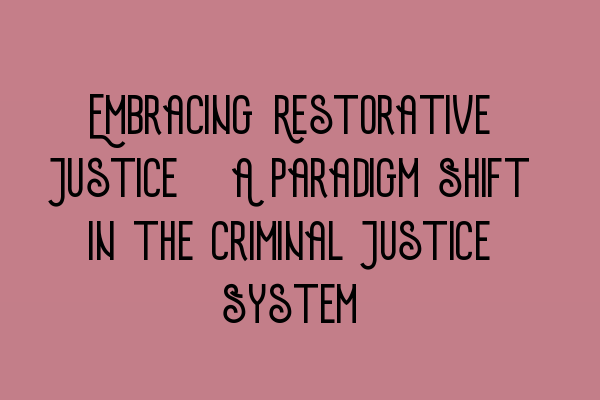Embracing Restorative Justice: A Paradigm Shift in the Criminal Justice System
As the criminal justice system continues to evolve, it is crucial to explore alternative approaches that can effectively address the needs of both victims and offenders. One such approach is restorative justice, which offers a paradigm shift in how we view and respond to crime. In this article, we will delve into the concept of restorative justice and its potential benefits for our society.
Understanding Restorative Justice
Restorative justice is a framework that aims to repair the harm caused by crime by focusing on the needs of the victims, the community, and the offenders themselves. It emphasizes the importance of accountability, dialogue, and healing, rather than simply punishing offenders. By involving all stakeholders in a collaborative process, restorative justice seeks to address the underlying causes of criminal behavior and prevent future offenses.
By embracing restorative justice, we can move away from the traditional punitive approach that often perpetuates a cycle of retribution and fails to address the root causes of crime. Instead, restorative justice encourages empathy, understanding, and active participation from all parties involved.
The Benefits of Restorative Justice
Restorative justice offers numerous advantages over the traditional criminal justice system. Firstly, it allows victims to actively participate in the resolution process, providing them with a voice and a sense of empowerment. Through dialogue and mediation, victims can express their feelings, ask questions, and potentially gain closure.
Moreover, restorative justice promotes a greater sense of accountability among offenders. By confronting the consequences of their actions and engaging in meaningful dialogue with those they have harmed, offenders have the opportunity to understand the impact of their behavior and take steps towards rehabilitation and reintegration into society.
Restorative justice also benefits the community by fostering healing and social cohesion. By involving community members in the resolution process, it strengthens trust and understanding within the community. This, in turn, can help prevent future incidents of crime and create a safer and more harmonious environment for all.
Implementing Restorative Justice: Challenges and Opportunities
While the concept of restorative justice holds great promise, its implementation may face challenges. One challenge is the need for proper training and support for those involved in the process, including victims, offenders, and facilitators. This ensures that restorative justice practices are conducted effectively and ethically.
Another challenge is the need for widespread public awareness and acceptance of restorative justice as a valid and valuable approach. Educating the public about its benefits and debunking misconceptions can help garner support and overcome resistance.
Fortunately, there are organizations and initiatives working towards promoting restorative justice. These include community-based programs, restorative justice centers, and training programs for legal professionals. By supporting and engaging with these initiatives, we can create a criminal justice system that is focused on healing, rehabilitation, and prevention rather than punishment.
Conclusion
Embracing restorative justice represents a paradigm shift in the criminal justice system, emphasizing accountability, healing, and prevention. By involving victims, offenders, and the community in a collaborative process, restorative justice offers an alternative approach that addresses the underlying causes of crime and promotes positive change.
If you’re interested in learning more about criminal law and practice in the UK, check out our related articles:
- SQE Exam Prep: Essential Study Materials for Aspiring Solicitors
- Demystifying the Solicitors Qualifying Examination Format
- LLC Formation Made Simple: Step-by-Step Guide for UK Entrepreneurs
- LLC Formation: A Step-by-Step Guide for UK Entrepreneurs
- Business Regulations in the UK: A Comprehensive Overview
